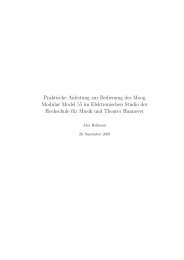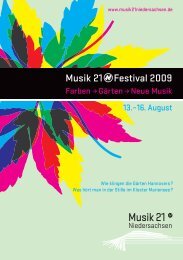Creating reverb efects using granular synthesis
Creating reverb efects using granular synthesis
Creating reverb efects using granular synthesis
You also want an ePaper? Increase the reach of your titles
YUMPU automatically turns print PDFs into web optimized ePapers that Google loves.
GIDELAYTIME INIT 0.5<br />
GITALETIME INIT 4<br />
; LENGTH OF CHUNK TO BE RECORDED FOR STRETCHING<br />
; PLAYBACK TIME OF THE RECORDED CHUNK<br />
; (0.5 SECONDS STRETCHED TO 4 SECONDS)<br />
INSTR 1<br />
KMETROTIME = 2<br />
KTRIG METRO KMETROTIME<br />
; ------- COUNTING TABLE NUMBERS FOR TIME STRETCH INSTRUMENT -------<br />
GKTABLENR = GKTABLENR + KTRIG<br />
IF GKTABLENR > 8 THEN<br />
GKTABLENR = 1<br />
ENDIF<br />
SCHEDKWHEN KTRIG, 0, 3, 2, 0, GIDELAYTIME + 0.4, GKTABLENR ;REC TRIG<br />
IF GKPLAYTABLENR > 0 THEN<br />
SCHEDKWHEN KTRIG, 0, 8, 3, 0, GITALETIME, GKTABLENR ;STRETCH TRIG<br />
ENDIF<br />
ENDIN<br />
Example1.1 :Time stretch trigger instrument.<br />
II. Using the partikkel opcode<br />
The “Partikkel” opcode is inspired by Curtis Roads book “Microsound” (2001) and is<br />
capable of generating all the varieties of <strong>granular</strong> <strong>synthesis</strong> described in his book. It is<br />
extremely flexible and offers a large set of control parameters.<br />
A design detail that profits the time stretch technique is that all the sound<br />
generating calculations is done, and stored in a list, before the grain is played. With the<br />
exception of FM modulation, none of the parameters of a grain can be changed during the<br />
life cycle of the grain. This is done to optimize the CPU usage. If one changes any of the<br />
parameters during the lifecycle of a grain, the changes apply before the next grain is<br />
played. Due to the obvious need to change the sample position when time stretching this<br />
is an advantage. With some <strong>granular</strong> tools the grain is re-pitch when the sample position<br />
is changed. This will not be a problem <strong>using</strong> the “partikkel” opcode.<br />
The “partikkel” opcode is also a good choice because one can use up to four<br />
sound sources in each instrument instance.<br />
With “partikkel” one has “per grain control” over some of the parameters,<br />
meaning that one can, for example, specify the pitch and the amp of each grain. This way<br />
one can spectrally compose the “<strong>reverb</strong> cloud”. A neat suggestion is to let every other<br />
grain be one octave above the original grains. With “per grain control” one can also<br />
adjust the amplitude level of the grains that are pitched one octave above the original<br />
grains.










